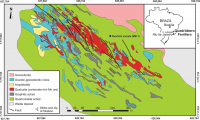Molybdenum isotopic signal survives in ancient, strongly metamorphosed rocks, a new study revealed
Molybdenum isotopic composition (98Mo/95Mo) provides important clues to paleoenvironmental changes of the Earthʼs oceans and atmosphere throughout the geological history. Previous studies were predominantly focused on black shales which reflected the degree of atmosphere oxygenation. Nevertheless, the new study published in the Scientific Reports journal (link here), also contributed by the Institute of Geology CAS, revealed that even ancient rocks (~2.1 Ga Mn ores from Brazil), which underwent high degrees of metamorphism (> 600 °C) retain Mo isotopic signal. Thus, these data argue for the presence of oxic–anoxic-stratified Palaeoproterozoic oceans. This is the first contribution since the new Mo isotopic methodology has been established in the joint laboratory of the Institute of Geology of the Czech Academy of Sciences and Czech Geological Survey.


